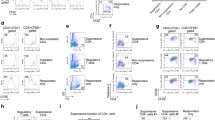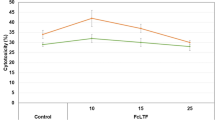Summary
We have shown that depletion of monocytes from human peripheral blood mononuclear cells (PBMC) byl-phenylalanine methyl ester (PheOMe) enhanced lymphokine-activated killer cell (LAK) generation by recombinant interleukin-2 (rIL-2) at high cell density. In this study, we have investigated the mechanism of action of PheOMe on LAK activation by using trypsin, chymotrypsin, tosylphenylalaninechloromethanol (TPCK, a chymotrypsin inhibitor), tosyl-l-lysinechloromethane (TLCK, a trypsin inhibitor), phenylalaninol (PheOH), and benzamidine. PBMC were treated with 1–5 mM PheOMe for 40 min at room temperature in combination with the various agents, washed and assessed for their effects on natural killer (NK) activity against K562 cells and monocyte depletion. The treated cells were then cultured with or without rIL-2 for 3 days. LAK cytotoxicity was assayed against51Cr-labeled K562 and Raji tumor target cells. TPCK at 10 µg/ml partially inhibited depletion of monocytes by PheOMe. TLCK did not prevent depletion of monocytes nor inhibition of NK activity induced by PheOMe. TPCK and TLCK inhibited NK activity by themselves. TPCK but not TLCK inhibited rIL-2 induction of LAK cells. On the other hand, PheOH and benzamidine (analogs of PheOMe) lacked any effect on monocyte depletion but abrogated the inhibitory effect of PheOMe on NK activity. They had no effect on rIL-2 activation of LAK activity enhanced by PheOMe. Trypsin potentiated the inhibitory effect of PheOMe on NK activity and monocyte depletion. Trypsin partially inhibited IL-2 activation of LAK activity enhanced by PheOMe. Chymotrypsin had little effect on NK activity but prevented the inhibitory effect of PheOMe on NK activity. It had little effect on monocyte depletion induced by PheOMe. PheOMe was hydrolysed by monocytes and chymotrypsin to Phe and methanol as determined by HPLC. TPCK inhibited hydrolysis of PheOMe by monocytes. Our data suggest that the effects of PheOMe on monocytes, NK cells and LAK activation involve protease activities of monocytes.
Similar content being viewed by others
References
Barlozzari T, Reynolds CW, Herberman RB (1983) In vivo role of natural killer cells: involvement of large granular lymphocytes in the clearance of tumor cells in anti-asialo GM1-treated rats. J Immunol 131: 1024
Goldman R, Kaplan A (1973) Rupture of rat liver lysosomes mediated byl-amino acid esters. Biochim Biophys Acta 318: 205–216
Goldman R, Naider F (1974) Permeation and stereospecificity of hydrolysis of peptide esters within intact lysosomes in vitro. Biochim Biophys Acta 333: 224–233
Grimm EA, Mazumder A, Zhang HZ, Rosenberg SA (1982) Lymphokine-activated killer cell phenomenon: lysis of natural killer-resistant fresh solid tumor cells by interleukin 2-activated autologous human peripheral blood lymphocytes. J Exp Med 155: 1823–1841
Hameed A, Lowrey DM, Lichtenheld M, Podack ER (1988) Characterization of three serine esterases isolated from human IL-2 activated killer cells. J Immunol 141: 3142–3147
Hoyer M, Meineko T, Lewis W, Zwilling B, Rinehart J (1986) Characterization and modulation of human lymphokine activated killer cell induction. Cancer Res 46: 2834
Kamada MM, Michon J, Ritz J et al (1989). Identification of carboxypeptidase and tryptic esterase activities that are complexed to proteoglycans in the secretory granules of human cloned natural killer cells. J Immunol 142: 609–615
Lavie G, Zucker-Franklin D (1989) Cell surface-associated proteinases in NK cell-mediated cytotoxicity: enhancement of enzyme expression is unique to activation with interferon γ. Cell Immunol 124: 202–211
Leung KH, Koren HS (1982) Regulation of human natural killing: II. Protective effect of interferon on NK cells from suppression by PGE2. J Immunol 129: 1742
Leung KH (1989) Human lymphokine-activated killer (LAK) cells: I. Depletion of monocytes from peripheral blood mononuclear cells byl-phenylalanine methyl ester: an optimaization of LAK cell generation at high cell density. Cancer Immunol Immunother 30: 247
Mule JJ, Ettinghausen SE, Spiess PJ, Shu S, Rosenberg SA (1986) Antitumor efficacy of lymphokine-activated killer cells and recombinant interleukin-2 in vivo: survival benefit and mechanisms of tumor escape in mice undergoing immunotherapy. Cancer Res 46: 676
Owen-Schaub LB, London WG, Yagita M, Grimm EA (1988) Functional differentiation of human lymphokine-activated killing (LAK) is distinct from expansion and involves dissimilar interleukin 2 receptors. Cell Immunol 111: 235–246
Phillips JH, Lanier LL (1986) Dissection of the lymphokine-activated killer phenomenon. Relative contribution of peripheral blood natural killer cells and T lymphocytes to cytolysis. J Exp Med 164: 814
Reeves JP (1979) Accumulation of amino acids by lysosomes incubated with amino acid methyl esters. J Biol Chem 254: 8914–8921
Reeves JP, Decker RS, Grie JS, Wildenthal K (1981) Intracellular disruption of rat heart lysosomes by leucine methyl ester: effects on protein degradation. Proc Natl Acad Sci USA 78: 4426–4429
Rosenberg SA, Lotze MT, Mul JJ (1988) New approaches to the immunotherapy of cancer using interleukin-2. Ann Intern Med 108: 853
Thiele DL, Lipsky PE (1985) Regulation of cellular function by products of lysosomal enyzme activity: elimination of human natural killer cells by a dipeptide ethyl ester generated froml-leucine methyl ester by monocytes or polymorphonuclear leukocytes. Proc Natl Acad Sci USA 82: 2468–2472
Thiele DL, Lipsky PE (1985) Modulation of human natural killer cell function byl-leucine methyl ester: monocyte-dependent depletion from human peripheral blood mononuclear cells. J Immunol 134: 786–793
Thiele DL, Lipsky PE (1986) Leu-Leu-OMe sensitivity of human activated killer cells: delineation of a distinct class of cytotoxic T lymphocytes capable of lysing tumor targets. J Immunol 137: 1399–1406
Author information
Authors and Affiliations
Rights and permissions
About this article
Cite this article
Leung, K.H. Human lymphokine-activated killer (LAK) cells: III. Effect ofl-phenylalanine methyl ester on LAK cell activation from human peripheral blood mononuclear cells: Possible protease involvement of monocytes, natural killer cells and LAK cells. Cancer Immunol Immunother 34, 31–36 (1991). https://doi.org/10.1007/BF01741321
Received:
Accepted:
Issue Date:
DOI: https://doi.org/10.1007/BF01741321




